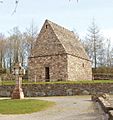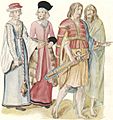Gaelic Ireland facts for kids
Gaelic Ireland was a special way of life in Ireland. It was how people lived, governed themselves, and what their culture was like. This system existed for a very long time, from ancient times until the early 17th century, which is the 1600s. Before the Normans arrived in 1169, Gaelic Ireland covered the entire island.
Contents
Life in Gaelic Ireland
In Gaelic Ireland, society was organized around families and clans. A clan was a group of families who believed they shared a common ancestor. Each clan had its own chief. These chiefs were usually chosen from the same ruling family.
How People Lived
Most people in Gaelic Ireland lived in the countryside. They lived in small villages or on farms. Their homes were often made of wood, mud, and thatch. Farming was very important, and people raised animals like cattle, sheep, and pigs. They also grew crops such as oats and barley.
Law and Order
Gaelic Ireland had its own unique laws called Brehon Laws. These laws were very old and were passed down through generations. They covered everything from how to settle arguments to how to deal with crime. Instead of prisons, punishments often involved paying fines or giving animals to the person who was wronged.
Arts and Culture
Culture was a big part of Gaelic life. People loved music, storytelling, and poetry. Bards, who were skilled poets and musicians, were highly respected. They would tell stories of heroes and ancient myths. Beautiful artwork, like the famous Book of Kells, was also created by Gaelic monks.
Religion and Beliefs
Before Christianity arrived, the Gaels had their own ancient beliefs and gods. Later, Christianity became very important. Monasteries, like the one at Glendalough, were centers of learning and art. Monks copied books, taught students, and helped spread Christianity throughout Ireland.
The Arrival of the Normans
In 1169, a big change happened. The Normans, who were warriors from France and England, arrived in Ireland. They began to take over parts of the island. This was the start of a long period where Gaelic Ireland and the Norman way of life existed side-by-side.
Changes After 1169
After the Normans arrived, Ireland became a mix of two cultures. The Normans built castles and introduced new ways of farming and governing. However, many Norman families eventually adopted Gaelic customs, language, and laws. They became known as the Old English.
Gaelic Revival
Even with the Normans present, Gaelic culture remained strong. In some areas, Gaelic chiefs continued to rule their lands. There were times when Gaelic power grew, and they even pushed back against the Normans. By the 1400s, much of Ireland was once again under Gaelic control or the control of the Old English who had become very much like the Gaels.
The End of Gaelic Ireland
The end of Gaelic Ireland came in the late 1500s and early 1600s. The English government, especially under Queen Elizabeth I and King James I, wanted to fully control Ireland. They launched several wars against the Gaelic chiefs and the Old English lords.
The Nine Years' War
One of the most important conflicts was the Nine Years' War (1594-1603). This war was led by powerful Gaelic chiefs like Hugh O'Neill. They fought bravely against the English army.
Flight of the Earls
Despite their efforts, the Gaelic chiefs were eventually defeated. In 1607, many of the most important Gaelic lords, including Hugh O'Neill, left Ireland forever. This event is known as the Flight of the Earls. It marked the end of the traditional Gaelic way of life and its independent rule.
New Beginnings
After the Flight of the Earls, the English took control of almost all of Ireland. They brought in new settlers from England and Scotland. This changed the culture and society of Ireland forever, leading to the Ireland we know today. However, many parts of Gaelic culture, like the Irish language, music, and stories, still live on and are celebrated today.
Images for kids
-
A page from the Book of Kells, made by Gaelic monastic scribes in the 9th century
-
A reconstruction of an early Irish Christian chapel and high cross
-
A reconstructed roundhouse and ráth at Craggaunowen, County Clare
-
A cattle raid shown in The Image of Irelande (1581)
-
A fantasy painting showing legendary hero Cúchulainn in battle
-
The summit of the Hill of Tara
-
A map of the early Irish raids and colonies of Britain during and following Roman rule in Britain.
-
Newgate, Dublin. 1608. Displaying the heads of Gaelic Irish rebels Cahir O'Doherty (right) and Phelim Reagh MacDaibhéid (left).
-
After Cromwell's victory, huge areas of land were confiscated from the Gaelic nobility and the Irish Catholics were banished to the lands of Connacht. The Commonwealth is said to have declared that all the Catholic Irish must go "to Hell or to Connaught".
-
Glendalough round tower
See also
 In Spanish: Irlanda celta para niños
In Spanish: Irlanda celta para niños





















